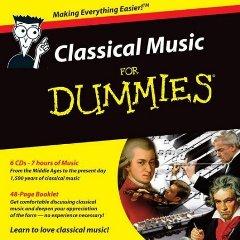Classical Music For Dummies (2010) CD2 - Classical Style
Classical Music For Dummies (2010) CD2 - Classical Style

01. Haydn - Trompette 1 - 3e mvt - Finale. Allegro - Muti-Andr? 02. Haydn - Sonate Piano.62 (Hob. XVI-52) - 3e mvt - Finale. Presto (extr.) - Pletnev 03. Boccherini - Quintette op. 11-5 G275 - 3e mvt - Menuet - Biondi 04. Mozart - Piano.21 KV 467 - 2e mvt - Andante - Zinman-Zacharias 05. Mozart - Piano.23 KV 488 - 2e mvt - Adagio - Zinman-Zacharias 06. Mozart - Sonate piano.11 KV 331 - 3e mvt - Alla Turca - Barenboim 07. Mozart - Requiem KV 626 - 7. Dies Irae - Giulini-Philharmonia Chorus 08. Mozart - Requiem KV 626 - 8. Lacrimosa - Giulini-Philharmonia Chorus 09. Mozart - Kleine Nachtmusik KV 525 - 1er mvt - Allegro (extr.) - Marriner 10. Mozart - Symphonie 25 KV 183 - 1er mvt - Allegro con brio - Marriner 11. Mozart - Symphonie 40 KV 550 - 1er mvt - Molto allegro - Marriner 12. Beethoven - Sonate piaNo.14 op. 27-2 Clair de Lune - 1er mvt - Adagio sostenuto - Kovacevich 13. Beethoven - Sonate piaNo.8 op. 13 Pathetique - 2e mvt - Adagio cantabile - Kovacevich 14. Beethoven - Symphonie 5 op. 67 - 1er mvt - Allegro con brio - Rattle 15. Beethoven - Symphonie 7 op. 92 - 2e mvt - Allegretto (extr.) - Rattle 16. Beethoven - Symphonie 9 op. 125 - 4e mvt - Ode a la joie - Rattle-Bonney-Remmert-Streit-Hampson-City of Birmingham Symphony Chorus 17. Beethoven - PiaNo.5 op. 73 Empereur - 2e mvt - Adagio un poco mosso - Vonk-Zacharias
Music from the Classical period is distinctive in style from what preceded and followed it. Some of the questions related to performance practice in Renaissance and Baroque music are less complex because at this point in Music history we have much clearer and more explicit indications from the composer concerning the tempo, dynamics, and expressive qualities of the Music under consideration.
Moreover, there have been public performances of this repertoire from the time of its composition to the present. This is both a help and a hindrance in light of the fact that through the last two centuries, certain Romantic conventions have become an accepted part of the performance of this music, and they are not always appropriate to authentic Classical style (this same Problem of inappropriate performance conventions added during the Romantic period exists with Baroque repertoire and, to a lesser extent, music from the Renaissance).
Classical choral music tends to be more homophonic and lighter in texture than that of the Baroque. This lightness needs to pervade the choral lines. There is still rhythmic energy and drive, but without the weightiness of Baroque music.
The lighter quality of Classical music also is derived from its slower harmonic movement. Baroque music, with its emphasis on vertical structure and use of figured bass and basso continuo, is characterized by frequent harmonic changes, sometimes on every beat. Classical music changes chords much less frequently, giving it a more graceful sweep and lightness of phrasing than that created by the pulsating feel of a harpsichordist realizing a Baroque figured bass part, supporting the choral singing with rapidly changing embellished chords. During the Classic period, the keyboard player was no longer typically the composer/ conductor, but instead was simply one of the players in the orchestra. The keyboard part should be much less obtrusive and less highly decorated than that of a Baroque work.
The choral music of the Classic period is generally conservative, and therefore often contains sections of free counterpoint, fugue, and use of continuo, reminiscent of the Baroque. This is particularly true in the music written in the early part of the period.
The Classical era was an era of formality. The music was characterized by careful attention to form and by elegance and restraint. The formal structure was based on the use of thematic development and harmonic structure.
The music of the Classical era is characterized by objectivity. While emotion is an important aspect of all music, in the Classical period, emotions were carefully controlled. This control is evident in the use of dynamics and expressive differences within sections or movements of a composition. The Baroque notion of terraced dynamics, coupled with the expression of a single emotion in a given section of a composition, was replaced by the classical trait of varying the emotional content of a given movement, section, or even a measure of a piece. Dynamically speaking, this was accomplished through the use of crescendo and decrescendo. ---cmed.faculty.ku.edu
download (mp3 @320 kbs):
